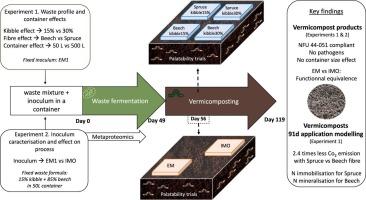结合发酵和蚯蚓堆肥的可持续宠物食品废物管理:废物概况和接种源的影响
IF 7.1
2区 环境科学与生态学
Q1 ENGINEERING, ENVIRONMENTAL
引用次数: 0
摘要
原料生产是宠物食品温室气体和土地使用的主要驱动因素。事实上,宠物食品工业每年使用近495,000平方公里的土地。然而,来自生产和解密产品的废物流仍未被充分开发为生产高质量土壤改良剂的资源。本研究提出了一种综合的方法,通过微生物发酵在蚯蚓堆肥之前使这些有机废物增值。进行了两个实验。(1)评估了粗粉掺入比(15% vs 30%)、纤维来源(云杉片,SF vs山毛榉锯末,BS)和容器大小(50 L vs 500 L)对发酵动力学、蠕虫偏好和蠕虫堆肥特性的影响。(2)评估了商业接种物(EM®)和本地来源微生物(IMO)的功能等效性。结果表明,在低粗粉掺入条件下,纤维类型显著影响发酵结果,BS降低pH值(从SF30%的9降至BS15%的5.2,P < 0.001),增加氧化还原电位(+ 213%,P < 0.001)。电导率受到粗粉比(+ 110%,P < 0.001)和纤维来源(+ 130%,P < 0.001)的强烈影响。蠕虫对bs基基质表现出强烈的偏好(7天内密度+ 493%,P < 0.001)。蚯蚓堆肥的氮和碳矿化速度比BS慢。容器大小对发酵没有影响。EM®和IMO在发酵效率、蠕虫吸引力和功能性微生物活性(宏基因组/元蛋白质组学分析)方面表现相当。这项工作表明,将微生物预消化与蚯蚓堆肥相结合,可以将宠物食品垃圾升级为有价值的土壤改进剂,同时支持当地的循环生物经济和可持续废物管理。本文章由计算机程序翻译,如有差异,请以英文原文为准。

Combining fermentation and vermicomposting for sustainable pet food waste management: Effects of waste profile and inoculum source
Ingredient production is the main driver of pet-food GHGs and land use. Indeed, the pet food industry uses nearly 495,000 km2 of land annually. Yet, waste streams from production and declassified products remain underexplored as resources to produce high quality soil amendment. This study proposes an integrated approach to valorise such organic wastes through microbial fermentation prior to vermicomposting.
Two experiments were conducted. (1) the effects of kibble incorporation ratio (15 % vs. 30 %), fibre source (spruce flakes, SF vs. beech sawdust, BS), and container size (50 L vs. 500 L) on fermentation dynamics, worm preference, and vermicompost properties were assessed. (2) the functional equivalence of commercial inoculum (EM®) and locally sourced indigenous microorganisms (IMO) was evaluated.
Results showed that fibre type significantly influenced fermentation outcomes at low kibble incorporation, with BS lowering pH (from 9 in SF30% to 5.2 in BS15%, P < 0.001) and increasing redox potential (+213 %, P < 0.001). Electroconductivity was strongly affected by both kibble ratio (+110 %, P < 0.001) and fibre source (+130 %, P < 0.001). Worms displayed strong preference for BS-based substrates (+493 % density in 7 days, P < 0.001). Vermicompost derived from SF exhibited slower nitrogen and carbon mineralisation than BS. Container size had no effect on fermentation. EM® and IMO performed equivalently in fermentation efficiency, worm attraction, and functional microbial activity (metagenomic/metaproteomic analyses).
This work demonstrates that combining microbial pre-digestion with vermicomposting can upcycle pet food waste into valuable soil amendments, while supporting local circular bioeconomy and sustainable waste management.
求助全文
通过发布文献求助,成功后即可免费获取论文全文。
去求助
来源期刊

Waste management
环境科学-工程:环境
CiteScore
15.60
自引率
6.20%
发文量
492
审稿时长
39 days
期刊介绍:
Waste Management is devoted to the presentation and discussion of information on solid wastes,it covers the entire lifecycle of solid. wastes.
Scope:
Addresses solid wastes in both industrialized and economically developing countries
Covers various types of solid wastes, including:
Municipal (e.g., residential, institutional, commercial, light industrial)
Agricultural
Special (e.g., C and D, healthcare, household hazardous wastes, sewage sludge)
 求助内容:
求助内容: 应助结果提醒方式:
应助结果提醒方式:


